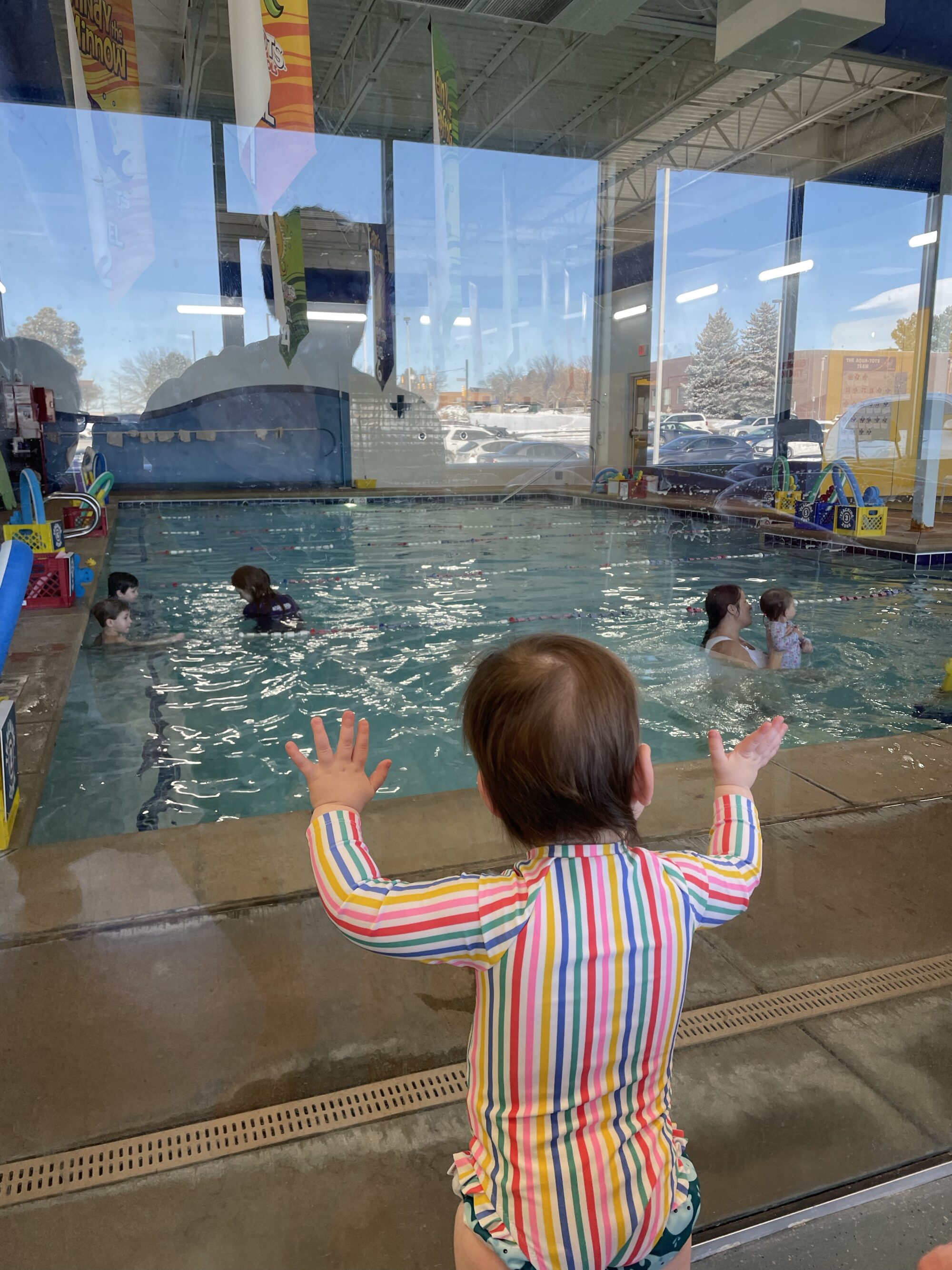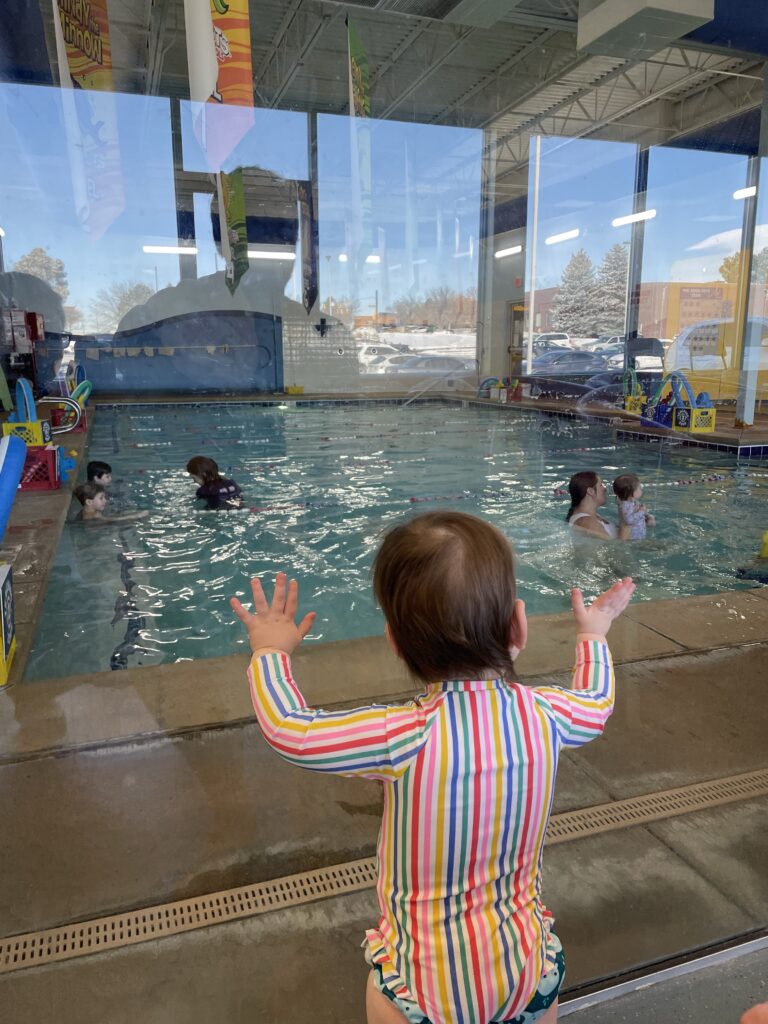
When I think back to how I was taught to swim as a child, I remember feeling extremely stressed. I was taught by some of my family members and I never felt like I was doing a good enough job. At the time I realized it was an important skill to have, but I did not have fun. The stress of trying to please my family members surpassed my ability to enjoy the process. I mostly felt very inadequate. I knew I wanted to take a different approach for my children and because of that, I decided to sign them up for swim classes.
My son started formal lessons after his second birthday and my daughter started just after she turned 6 months. Between one interstate move, a pandemic, and two kids, I’ve tried four different swim schools. This post is to share my experiences, lessons learned, and to help you prepare when if you’re ready to get your kiddo(s) started in swim lessons.
Why do baby/toddler swim lessons?
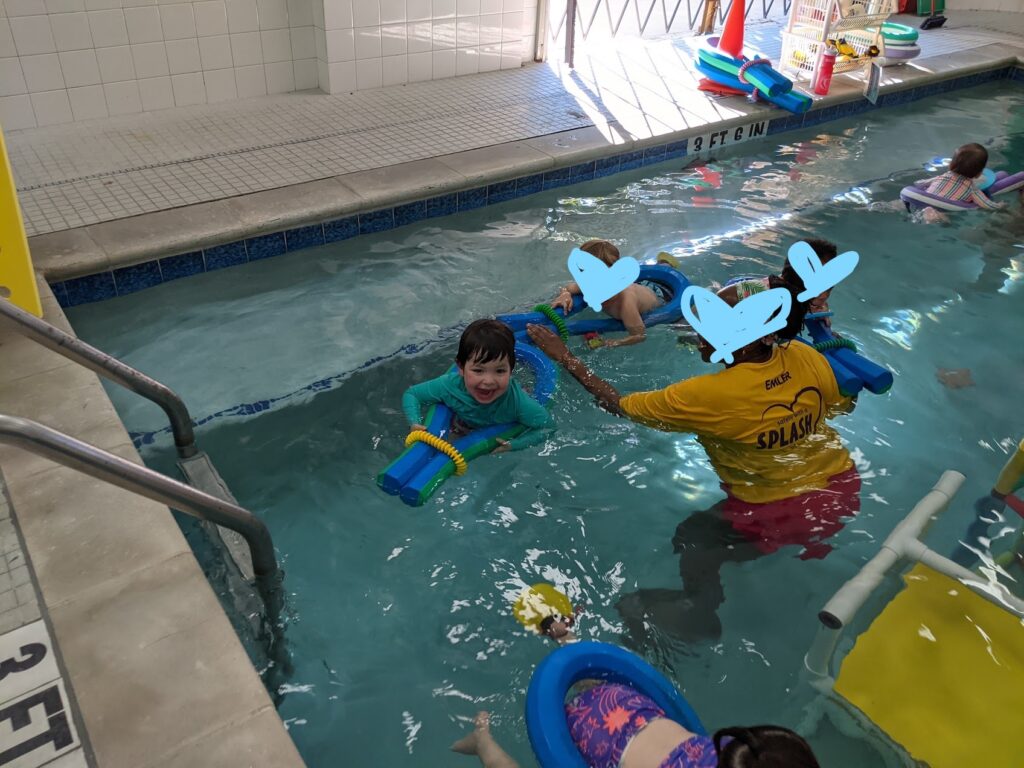
I got into some of my personal reasons for being passionate about swim lessons, but after starting, I realized there are so many more benefits to babies/kids learning swim lessons. Some of the benefits I’ve learned along the way include:
- My kiddos sleep really well after a swim lesson and generally are in a better mood when they sleep well after swim
- Most classes are indoors, therefore making it a great reliable activity year round
- Kids get a boost of confidence hearing about how they’re improving from their instructors
- Breath control is learned and your kid becomes less likely to drown because they learn to not breathe under water in a slow and controlled environment.
- Drowning is one the leading cause of death among children ages 1-4 according to the CDC. Children used to swimming in floatation devices/toys sometimes don’t know that they can’t float without them. Swimming lessons help them learn their abilities in the pool and help reduce the risk of drowning
When is the Best Age to Start Swim Lessons?
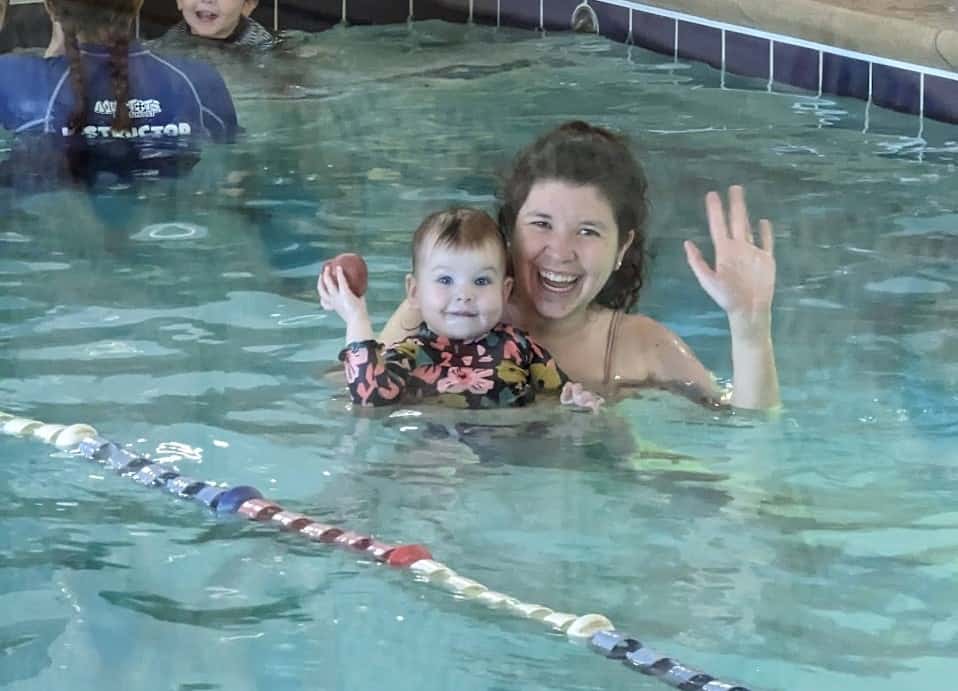
My Son’s Experience
Starting swim lessons can be hard at any age. From what I’ve seen, the first lesson or two is filled with plenty of tears. Initially, I tried starting swim lessons with my son after his first birthday. The lesson was ROUGH. Part of what made it rough was that the class format just didn’t seem right for us, but most of it was just that separation anxiety was at its peak for my 12 month old. I probably could have stuck it out to see if it got better, but because I didn’t feel the school was the right fit for us, I didn’t try again.
After his second birthday we made our second attempt at swim lessons. Although this lesson also involved plenty of tears, there were glimmers of excitement and fun from him! By the second lesson he was really loving it. Most of the success probably had to do with his age, but I think it also helped that we found a school that fit with his needs well. Different toys and a rotation of skill building activities kept him interested and engaged.
My Daughter’s Experience
I hesitantly started my daughter in swim lessons at 6 months old. My husband, son, daughter, and I were able to join the same class at the same time and I thought it would be our only chance for my kiddos to be in a class at the same level. Genuinely, I couldn’t imagine there being a benefit for a baby as young as 6 months, but I was absolutely proved wrong.
The first lesson involved no tears. My baby girl was holding her breath better than kids much older than her and within weeks she was kicking/swimming independently for a couple of seconds at a time. Comparing my daughter’s experience to my son’s, the introduction to swimming was just so much easier. Of course there is nothing wrong with starting later, it was just wonderful skipping the first lesson or two that involved lots of tears.
What to Expect at Swim Lessons

Under 2.5 Years
For kiddos under 2.5 (+/- depending on individual location policies), the child will usually be in a parent/tot class unless you sign up for private lessons. One parent joins the child in the pool and you will help your child through the various activities and build on your child’s skills from class to class.
In the first few classes, you may just let water splash your child’s chin and not actually submerge your child under water until they’re a little bit more comfortable in the water. The activities during the class will be geared towards building skills to help your child learn to be safe in the water or learn how to properly move through the water. There’s usually cute little cheesy songs that make your kiddo smile throughout the class and lots of cheers and praise. As a parent, the classes can feel a little cheesy, but the kiddo smiles make it worth it!
Over 2.5 Years
For kids beyond the parent/tot class stage, they will usually join a couple of kids their age and an instructor in the pool. Instructors guide the group of children through swim skill building activities while they sit/stand in a safe area in the pool. In between the group “practice” of activities, the instructors typically give each child an individual turn to practice their skills in the pool. The other children sit on the ledge and watch or make little toddler jokes to each other.
Choosing the right location

Before committing to any location, I recommend asking for a trial lesson. Most swim locations give you a free one time lesson to try out their location. While the first lesson tends to be a difficult one, you can still assess if this seems like a good location for your family. Some things I look out for include:
- Student to teacher ratio: Most schools will limit it to four students per one teacher. A higher ratio involves a lot of down time.
- Pool temperature: Does your little one seem comfortable with the temperature of the pool? This is something you won’t be able to change about a location. If your little one is shivering in the pool, he/she won’t enjoy lessons. (Note: it can be cold when getting out, but they shouldn’t feel cold while in the pool).
- Facilities: Do they have a good area for you/your kids to change? Are you able to watch your child’s lesson easily if you’re not in the pool with them?
- Lesson Format: Do they have a predictable class format? Look at the other children swimming. Are engaged in the class and do they seem to enjoy their time here? Do you hear them singing songs your child might like? Do they encourage water submersion for the children (when appropriate)?
- Number of Classes at One Time: is there ample space between the different classes going on?
- Make up lesson policy: how does this work at this swim school? Will this work for your family?
Choosing the right lesson time
Choosing the right lesson time is very dependent on your family and what works best for your individual needs. Ideally, you can create a weekly routine to hep your child feel secure.
When we started swim lessons in Dallas, we ate at a nearby taco place right before lessons, loaded our toddler up on chips and queso, and then rushed over to swim afterwards. Our little one quickly learned a predictable routine before swim and was in a better mood for swim lessons when he had a full tummy. Eventually we switched dinner to right after swim lessons because it worked out better with our lesson time. Keeping this routine consistent from week to week has really helped our toddler know what to expect next and enjoy the experience.
Preparing for Swim Success
Setting up for Kiddo Fun
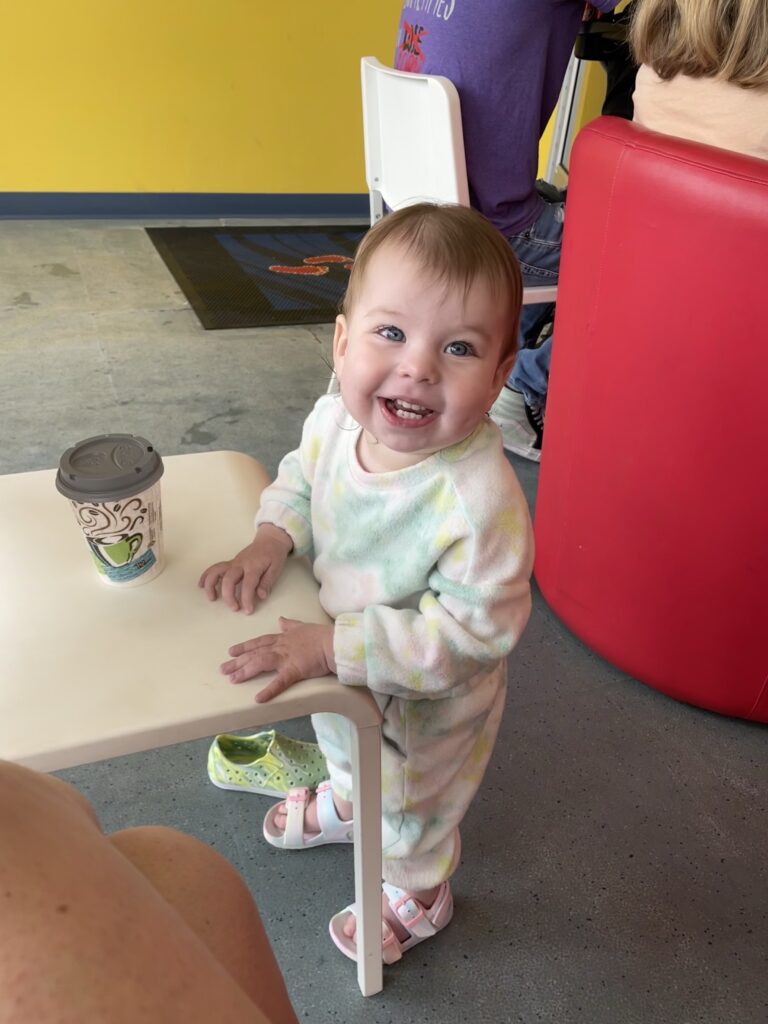
Starting swim lessons for the first time (or going to a lesson in general) can feel a bit stressful for any toddler. A couple of things I try to do to help tee my kiddos up for success:
- Do your best to arrive early – Provide ample time to get your kiddo changed when you get there. When you’re stressed about a time crunch, your kiddo will feel it. Shared time crunch anxiety happens regardless of how many lessons they’ve had before.
- Fill the Toddler Tummy – I usually try to give my kiddo a snack right before we leave the house (if not grabbing dinner somewhere beforehand). If I run out of time, I pack one in the car for him/her to eat on the way there. Snacks make for a happier kiddo in my house.
- Engage in your Child’s Lesson – if you’re not in the pool with your kiddo, watch their lesson and give them thumbs up, claps, cheers, whatever to let them know you are rooting for them and having fun watching them! If you’re in the pool with your kiddo, cheer for the other kids in the pool. Encourage your child to root for others. Let your kiddo know they’re doing great. Give lots of high fives! Positive reinforcement goes a long way in the pool. Conversely, don’t get competitive. The mood goes downhill quick when parent frustration shows. Try to keep it all about having fun. It is OK if they don’t want to do all the activities in the pool.
Packing for Mama Success
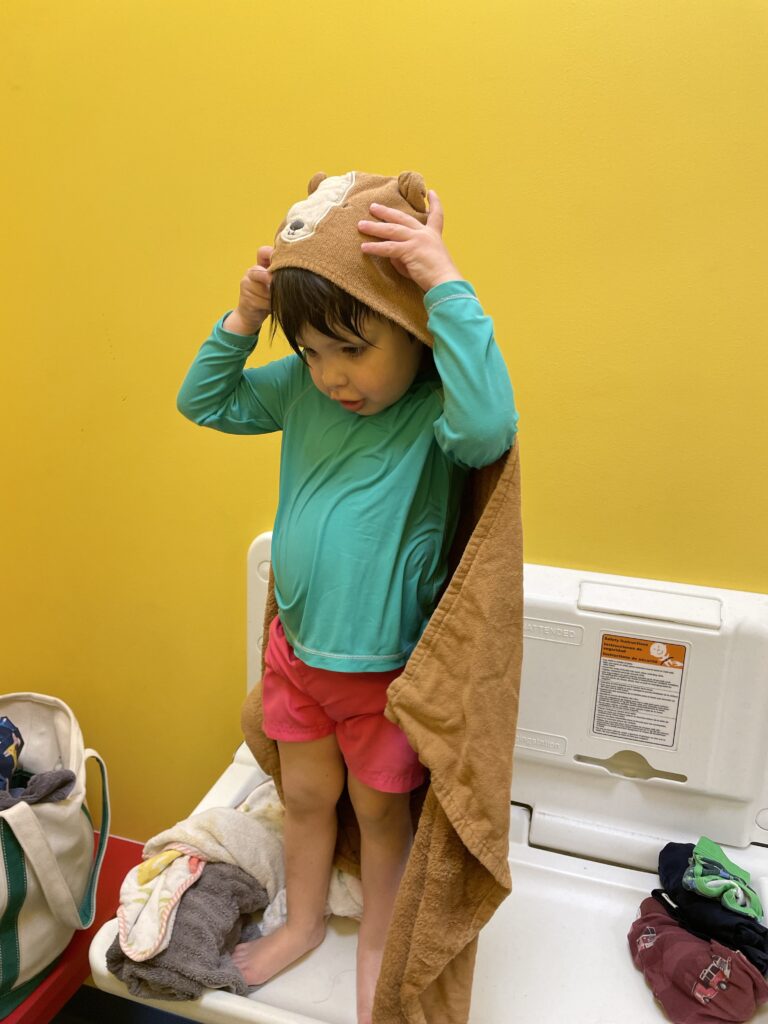
When you have everything you need, you are less stressed and your kids have more fun. Prepare your swim bag the night before to tee yourself up for success and avoid a time crunch. Here’s some of the things I pack:
- Change of clothes: if I’m in the pool with my kiddo, I dress myself for swim under my clothes before I leave home. I pack my underwear in a wet dry bag to change into after the lesson. I usually change my kids into swimsuits at our swim school but if I want them to wear something different than they were before swim, I pack those clothes too
- Swimsuits/reusable swim diaper: Pack the kiddos’ swimsuits in a separate wet dry bag from the change of clothes wet dry bag mentioned above. I use the smaller zipper for storing two reusable swim diapers per kid. I like these because they’re bigger than others I’ve tried and adjust down for little bodies well too!
- Extra disposable swim diapers: Swim schools have different diapering policies. Regardless of policy, I typically pack extras of these just in case. If a mama is caught without a swim diaper I offer these up 🙂 Moms gotta look out for eachother!
- Extra long hooded swim towels: I love these H&M hooded towels for my kiddos after swim lessons. There’s a lot of material to them compared to other hooded towels, plus they’re super cute!
- Extra diapers/pull ups: If it’s nap time after lessons, change them into a pull-up before headed out. They’ll likely be exhausted after a lesson and this makes the nap transition easier.
- Snack bag with LOTS of snacks: same snack pouch mentioned in my travel post. I fill a separate snack bag up specifically for my swim bag. Hand the snack bag to your kid after the lesson and let him/her choose their snack. My kiddos tear through snacks immediately after swim lessons.
- Lotion: Pools at swim lessons are understandably very chlorinated. If I can sneak in some lotion on my kiddos skin before getting their clothes on, I try to!
- Dupe Native Shoes: Socks without shoes after a lesson is a win in my book. I love to quickly slip these shoes on without socks (and at a fraction of the cost of actual native shoes). My little girl has also been loving these sandals after swim.
Any questions about swim lessons? Let me know in the comments!
